Agricultural Structure Adjustment and Rural Poverty Alleviation in the Agro-Pastoral Transition Zone of Northern China: A Case Study of Yulin City
Abstract
1. Introduction
2. Materials and Methods
2.1. Site Description
2.2. Data Sources
2.3. Methodology
2.3.1. Agricultural Structural Variability Index
2.3.2. Specialization Index
2.3.3. Actual Growth Rate of Rural Per Capita Net Income
2.3.4. Statistical Analysis
3. Results
3.1. Rural Poverty Ratio
3.2. Primary Industry Development
3.2.1. Proportion of Primary Industry
3.2.2. Ratio of Agriculture to Animal Husbandry
3.3. Agricultural Development
3.3.1. Agricultural Structural Variability Index
3.3.2. Agricultural Specialization Index
3.4. Rural Income
3.4.1. Rural Per Capita Net Income
3.4.2. Actual Growth Rate of Rural Per Capita Net Income
3.5. Relationships Between Rural Poverty and Agricultural Development
4. Discussions
5. Conclusions
Author Contributions
Funding
Conflicts of Interest
References
- Liu, Y.S. Research on the urban-rural integration and rural revitalization in the new era in China. Acta Geogr. Sin. 2018, 73, 637–650. [Google Scholar]
- Long, H.L.; Tu, S.S. Theoretical thinking of rural restructuring. Prog. Geogr. 2018, 37, 581–590. [Google Scholar]
- Han, D.; Qiao, J.J.; Ma, Y.L. Spatio-temporal differentiation and evolution of rurality under the background of rapid industrialization:A case study of Gongyi city, Henan province. Geogr. Res. 2017, 36, 2405–2418. [Google Scholar]
- Potter, C.; Tilzey, M. Agricultural policy discourses in the European post-Fordist transition: Neoliberalism, neomercantilism and multifunctionality. Prog. Hum. Geogr. 2005, 29, 581–600. [Google Scholar] [CrossRef]
- Wilson, G.A. Post-Productivist and multifunctional agriculture. Int. Encycl. Hum. Geogr. 2009, 12, 379–386. [Google Scholar]
- Long, H.L.; Liu, Y.S.; Li, X.B.; Chen, Y.F. Building new countryside in China: A geographical perspective. Land Use Policy 2010, 27, 457–470. [Google Scholar] [CrossRef]
- Liu, Y.S.; Li, Y.H. Revitalize the world’s countryside. Nature 2017, 548, 275–277. [Google Scholar] [CrossRef]
- Li, Y.H.; Yan, J.Y.; Wu, W.H.; Liu, Y.S. The process of rural transformation in the world and prospects of sustainable development. Prog. Geogr. 2018, 37, 627–635. [Google Scholar]
- Liu, X.P.; Li, Y.H.; Wang, Y.J.; Guo, Z.J.; Zheng, F. Geographical identification of spatial poverty at county scale. Acta Geogr. Sin. 2017, 72, 545–557. [Google Scholar]
- Qian, L.Q.; Yu, M.; Lin, W.X. Poverty reduction within the framework of SDGs and Post-2015 Development Agenda. Adv. Clim. Chang. Res. 2015, 6, 67–73. [Google Scholar]
- Guo, Y.Z.; Zhou, Y.; Liu, Y.S. Targeted poverty alleviation and its practices in rural China: A case study of Fuping county, Hebei Province. J. Rural Stud. 2019. [Google Scholar] [CrossRef]
- Long, H.L.; Zou, J.; Liu, Y.S. Differentiation of rural development driven by industrialization and urbanization in eastern coastal China. Habitat Int. 2009, 33, 454–462. [Google Scholar] [CrossRef]
- Liu, Y.S.; Fang, F.; Li, Y.H. Key issues of land use in China and implications for policy making. Land Use Policy 2014, 40, 6–12. [Google Scholar] [CrossRef]
- Zhou, Y.; Guo, Y.Z.; Liu, Y.S.; Wu, W.X.; Li, Y.R. Targeted poverty alleviation and land policy innovation: Some practice and policy implications from China. Land Use Policy 2018, 74, 53–65. [Google Scholar] [CrossRef]
- Ren, T.T.; Zhou, Z.X. Influence of agricultural structure transformation on ecosystem services and human well-being: Case study in Xi’an metropolitan area. Acta Ecol. Sin. 2018, 39, 2353–2365. [Google Scholar]
- Hossain, M. Poverty Alleviation through Agriculture and Rural Development in Bangladesh; Center for Policy Dialogue: Dhaka, Bangladesh, 2003. [Google Scholar]
- Gollin, D.; Parente, S.; Rogerson, R. The role of agriculture in development. Am. Econ. Rev. 2002, 92, 160–164. [Google Scholar] [CrossRef]
- Irz, X.; Lin, L.; Thirtle, C.; Wiggins, S. Agricultural productivity growth and poverty alleviation. Dev. Policy Rev. 2001, 19, 449–466. [Google Scholar] [CrossRef]
- Valdés, A.; Foster, W. Reflections on the role of agriculture in pro-poor growth. World Dev. 2010, 38, 1362–1374. [Google Scholar] [CrossRef]
- Li, E.L.; Xu, Y.N.; Yong, Y.J.; Wei, L.X. Agricultural structure adjustment and rural transformation development in China: Taking Gongyi City and Yanling County as examples. Prog. Geogr. 2018, 37, 698–709. [Google Scholar]
- Herrendorf, B.; Rogerson, R.; Valentinyi, A. Growth and Structural Transformation. In Research, N.B. o. E. Ed. Available online: https://www.nber.org/papers/w18996.pdf:2013 (accessed on 18 December 2019).
- Pan, H.F.; Liu, Y.Q.; Wei, G.H. Impact of agricultural industrial structure adjustment on energy conservation and income growth in Western China: A statistical study. Ann. Oper. Res. 2012, 228, 23–33. [Google Scholar] [CrossRef]
- Zhen, N.H.; Fu, B.J.; Lü, Y.H.; Zheng, Z.M. Changes of livelihood due to land use shifts: A case study of Yanchang County in the Loess Plateau of China. Land Use Policy 2014, 40, 28–35. [Google Scholar] [CrossRef]
- Costantini, V.; Monni, S. Environment, human development and economic growth. Ecol. Econ. 2008, 64, 867–880. [Google Scholar] [CrossRef]
- Mink, S.D.; Mundial, B. Poverty, Population, and the Environment; World Bank: Washington, DC, USA, 1993. [Google Scholar]
- Wang, Y.S.; Li, Y.H. Promotion of degraded land consolidation to rural poverty alleviation in the agro-pastoral transition zone of northern China. Land Use Policy 2019, 88. [Google Scholar] [CrossRef]
- Liu, Y.S.; Zhang, X.P.; Li, X.W.; Gao, J. Mechanism and regulation of land degradation in Yulin district. J. Geogr. Sci. 2003, 13, 217–224. [Google Scholar]
- Li, Y.R.; Cao, Z.; Long, H.L.; Liu, Y.S.; Li, W.J. Dynamic analysis of ecological environment combined with land cover and NDVI changes and implications for sustainable urban–rural development: The case of Mu Us Sandy Land, China. J. Clean. Prod. 2016, 142, 697–715. [Google Scholar] [CrossRef]
- Geng, X.L. Research on the Expansion of Agricultural Science and Technology in Yulin City; Northwest Agriculture and Forestry University: Shaanxi Province, China, 2014. [Google Scholar]
- Farris, J.; Larochelle, C.; Alwang, J.; Norton, G.W.; King, C. Poverty analysis using small area estimation: An application to conservation agriculture in Uganda. Agric. Econ. 2017, 48, 671–681. [Google Scholar] [CrossRef]
- Shackleton, C.M.; Shackleton, S.E.; Cousins, B. The role of land-based strategies in rural livelihoods: The contribution of arable production, animal husbandry and natural resource harvesting in communal areas in South Africa. Dev. South. Afr. 2001, 18, 581–604. [Google Scholar] [CrossRef]
- Delgado, C.; Rosegrant, M.; Steinfeld, H.; Ehui, S.; Courbois, C. Livestock to 2020: The next food revolution. In 2020 Vision Initiative Food, Agriculture, and the Environment Discussion Paper 28; International Food Policy Research Institute: Washington, DC, USA, 1999. [Google Scholar]
- Wang, X.; Huang, J.; Rozelle, S. Off-farm employment and agricultural specialization in China. China Econ. Rev. 2016, 42, 155–165. [Google Scholar] [CrossRef]
- Kurosaki, T. Specialization and diversification in agricultural transformation: The case of West Punjab, 1903–92. Am. J. Agric. Econ. 2003, 85, 372–386. [Google Scholar] [CrossRef]
- Li, D.; Hruska, T.; Talinbayi, S.; Li, W.J. Changing Agro-Pastoral Livelihoods under Collective and Private Land Use in Xinjiang, China. Sustain. Basel 2019, 11, 166. [Google Scholar] [CrossRef]
- Xu, W.Z.; Bo, Y.J.; Liu, C.Y.; Zhang, X. Analysis of the Present Situation and Development Countermeasure of Forage Industry in Yulin City of Shaanxi Province. Value Eng. 2017, 14, 222–223. [Google Scholar]
- Liu, J.S.; Chen, X.; Cao, J.H. The mechanisms of the industrialization of precise poverty alleviation. China Popul. Resour. Environ. 2017, 27, 127–135. [Google Scholar]
- Liu, Y.S.; Zheng, X.Y.; Wang, Y.S.; Cao, Z.; Li, Y.H.; Wu, W.H.; Liu, Z.J.; Liu, H.H.; Li, R. Land consolidation and modern agricultural: A case study from soil particles to agricultural systems. J. Geogr. Sci. 2018, 28, 1864–1874. [Google Scholar]
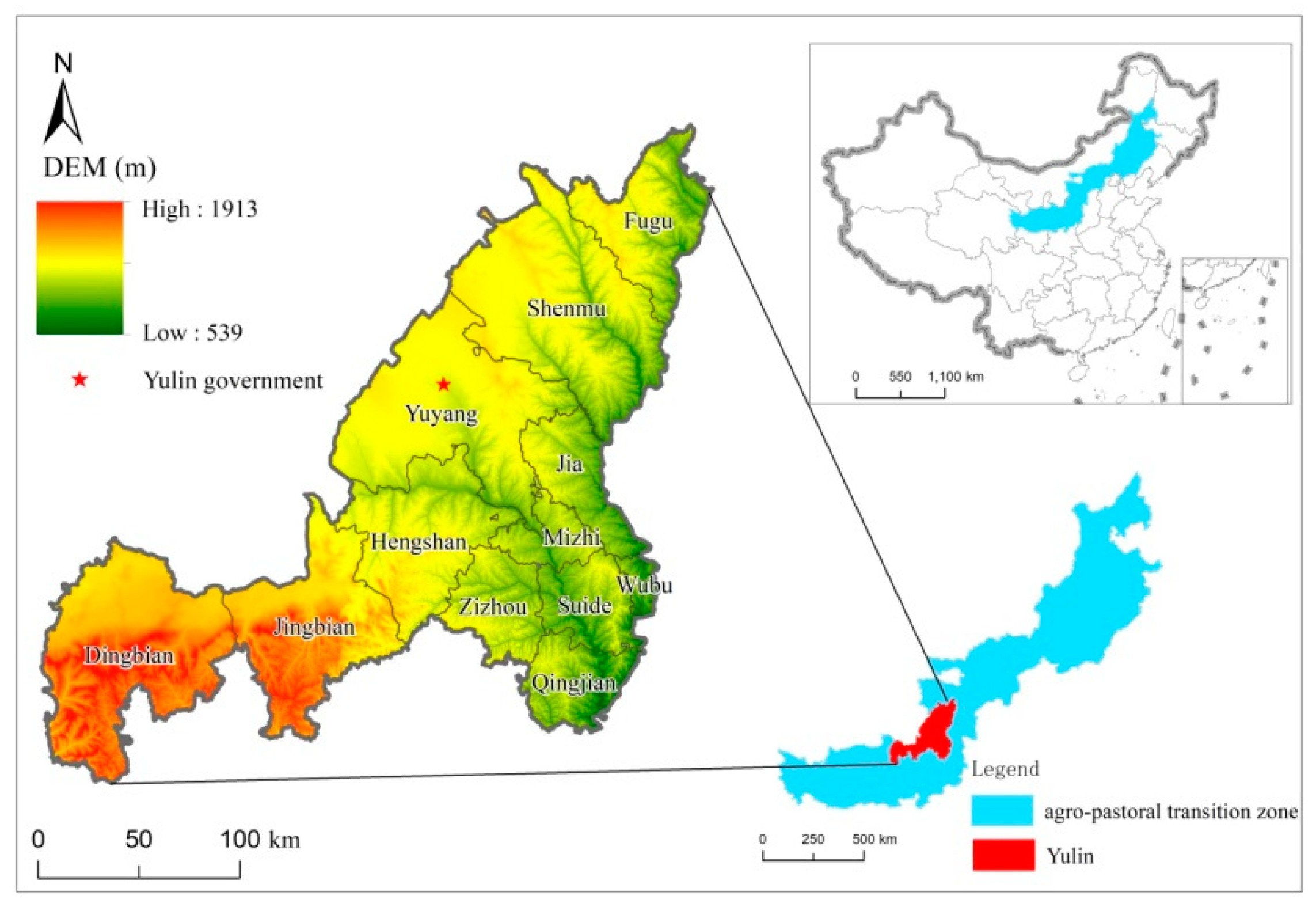
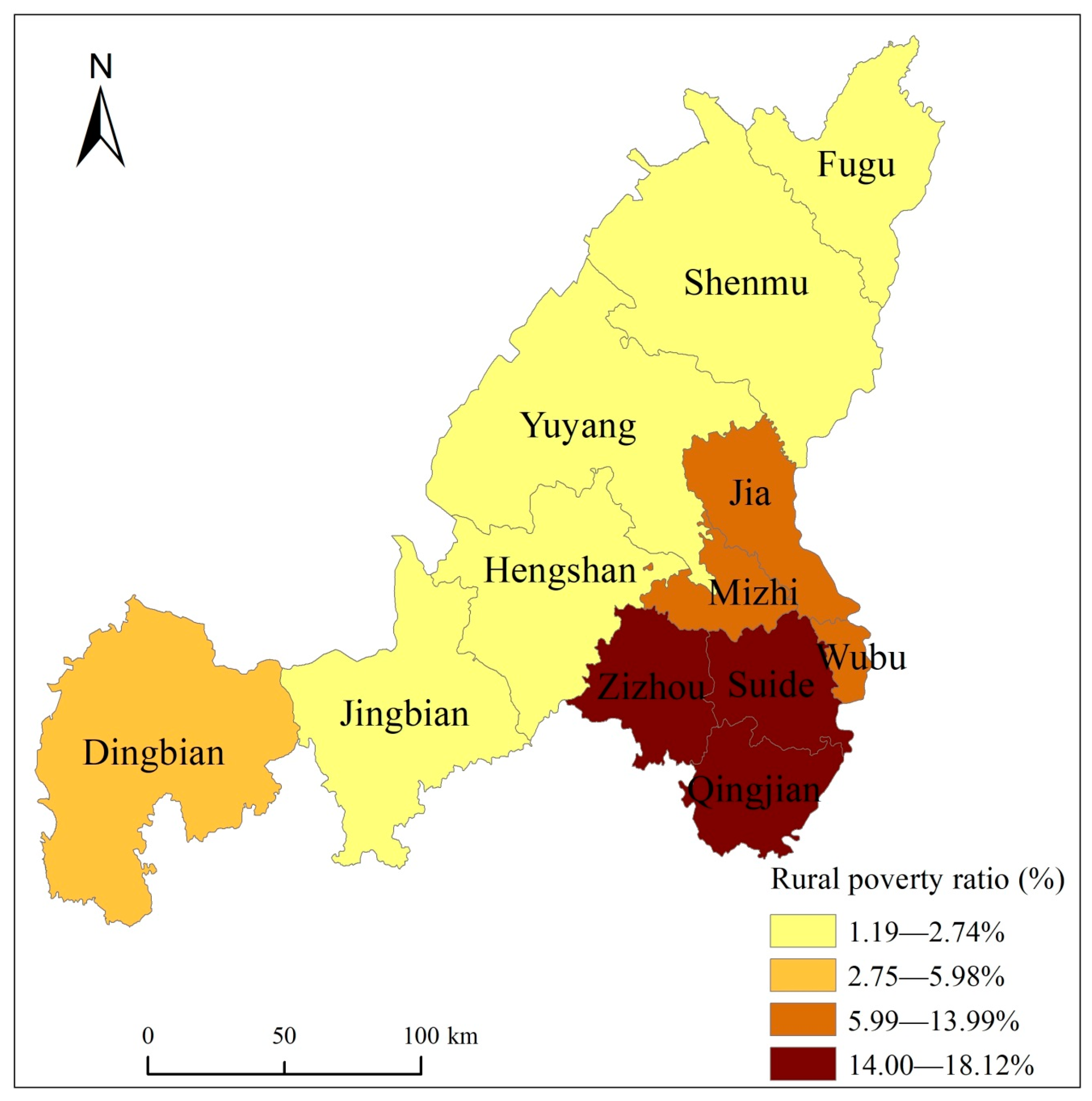
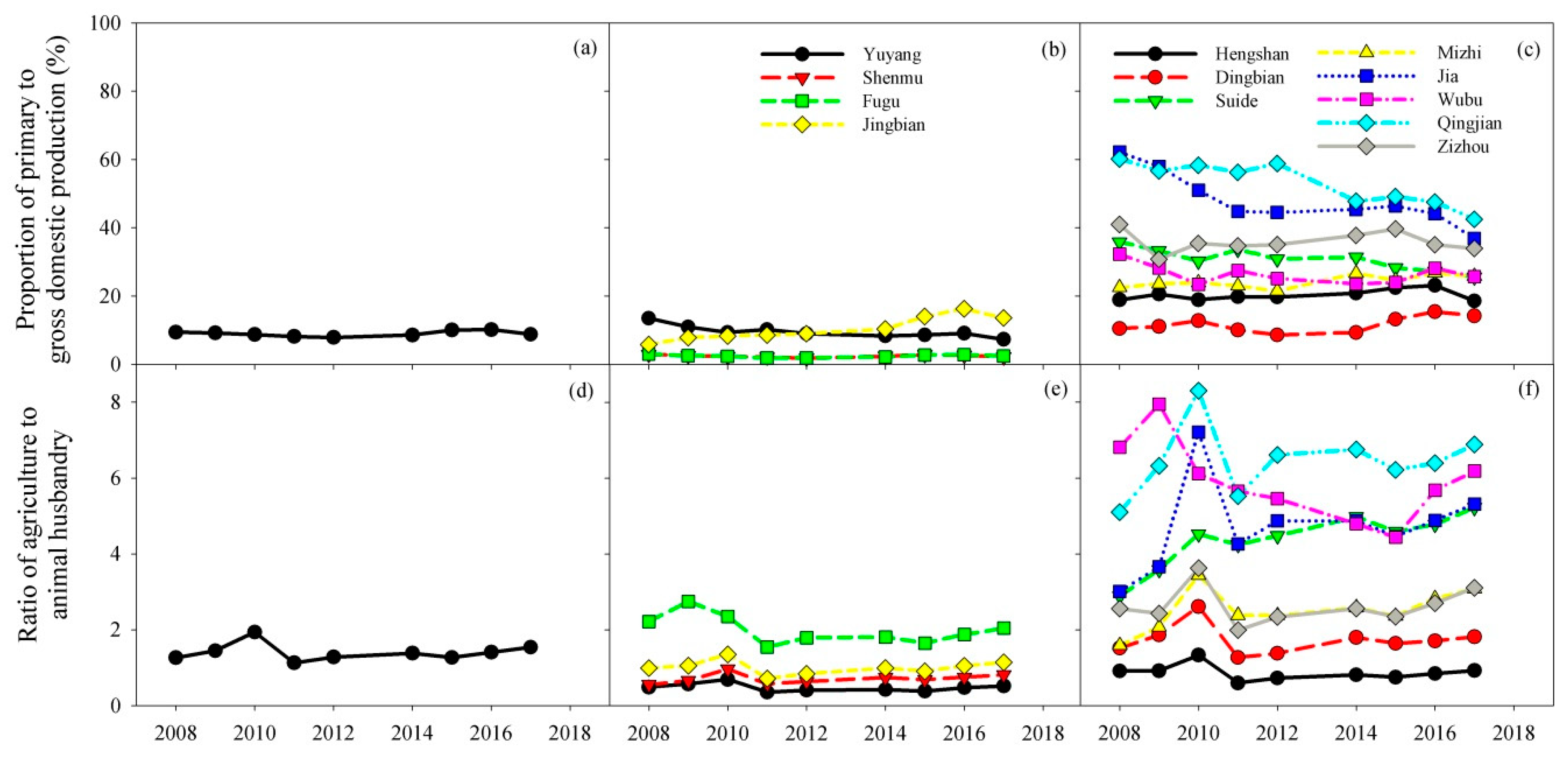
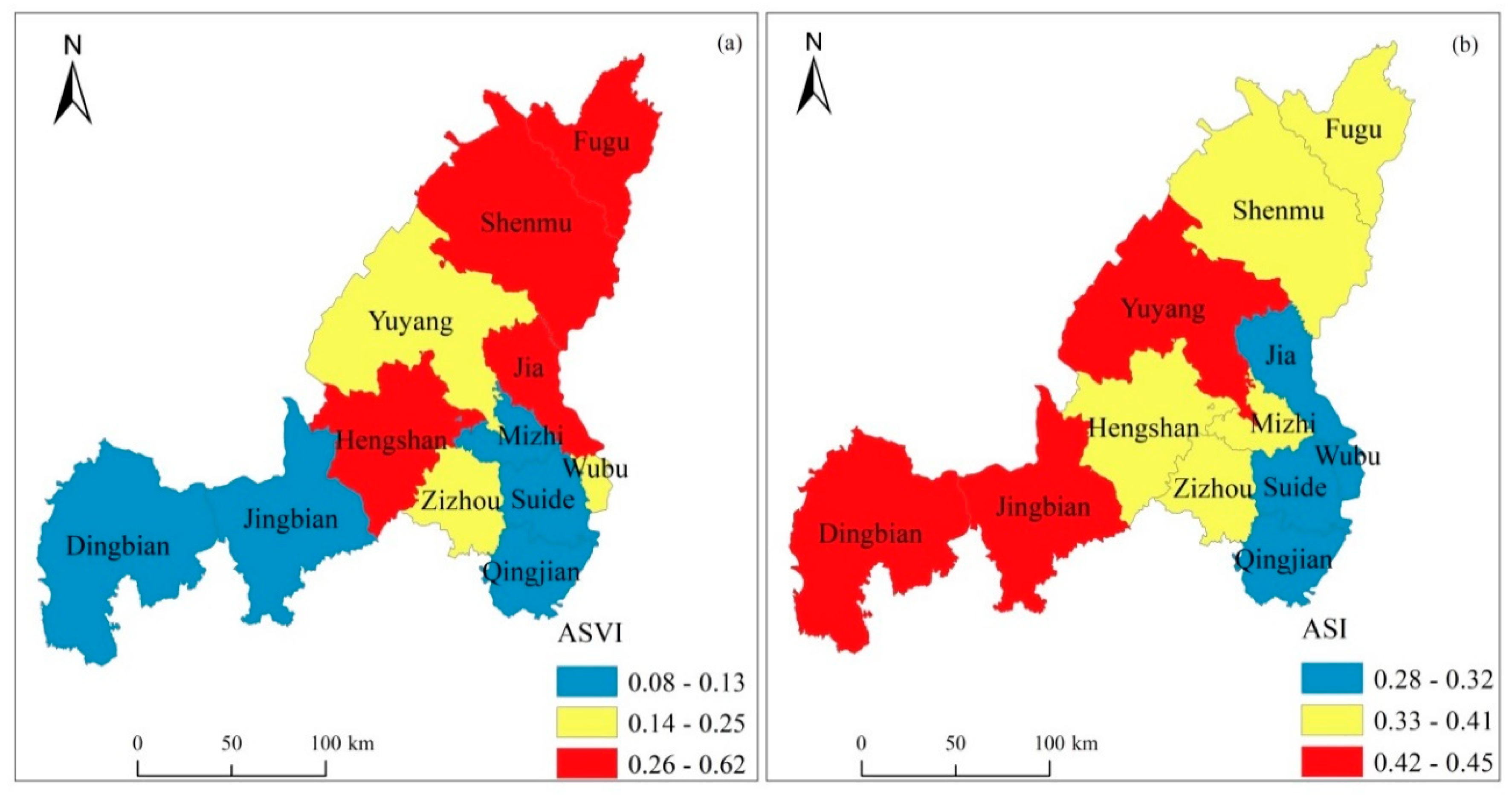
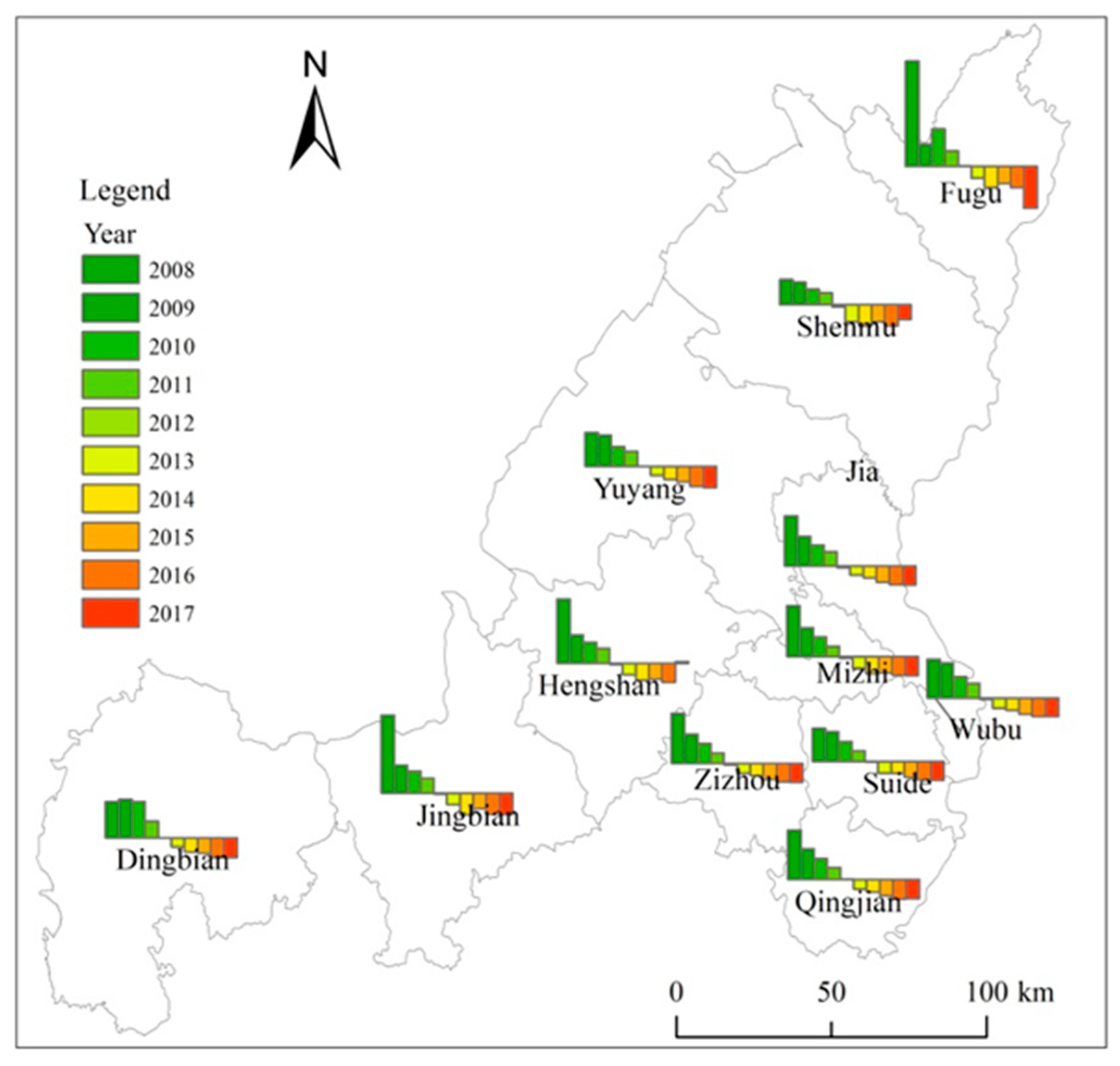
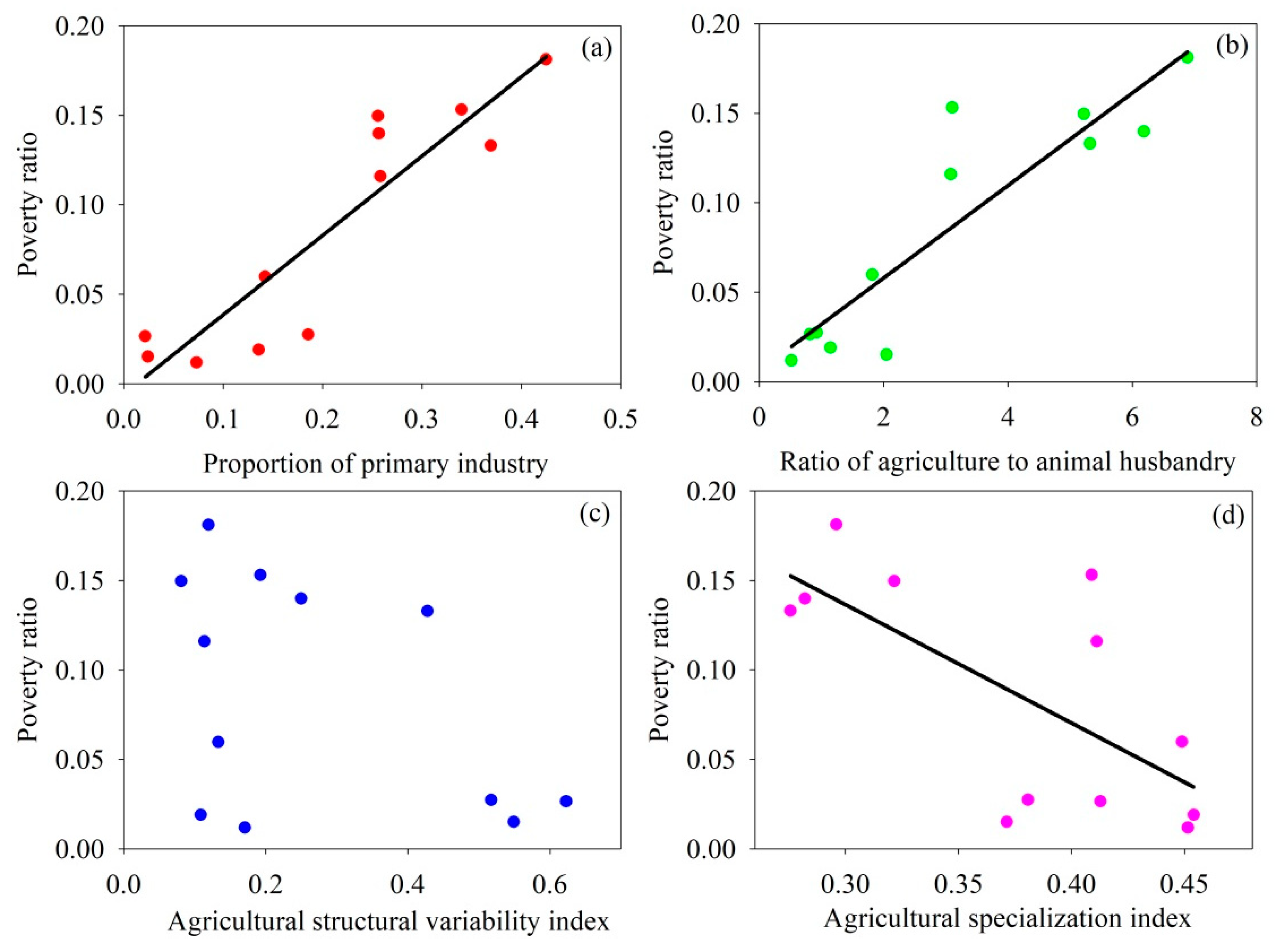
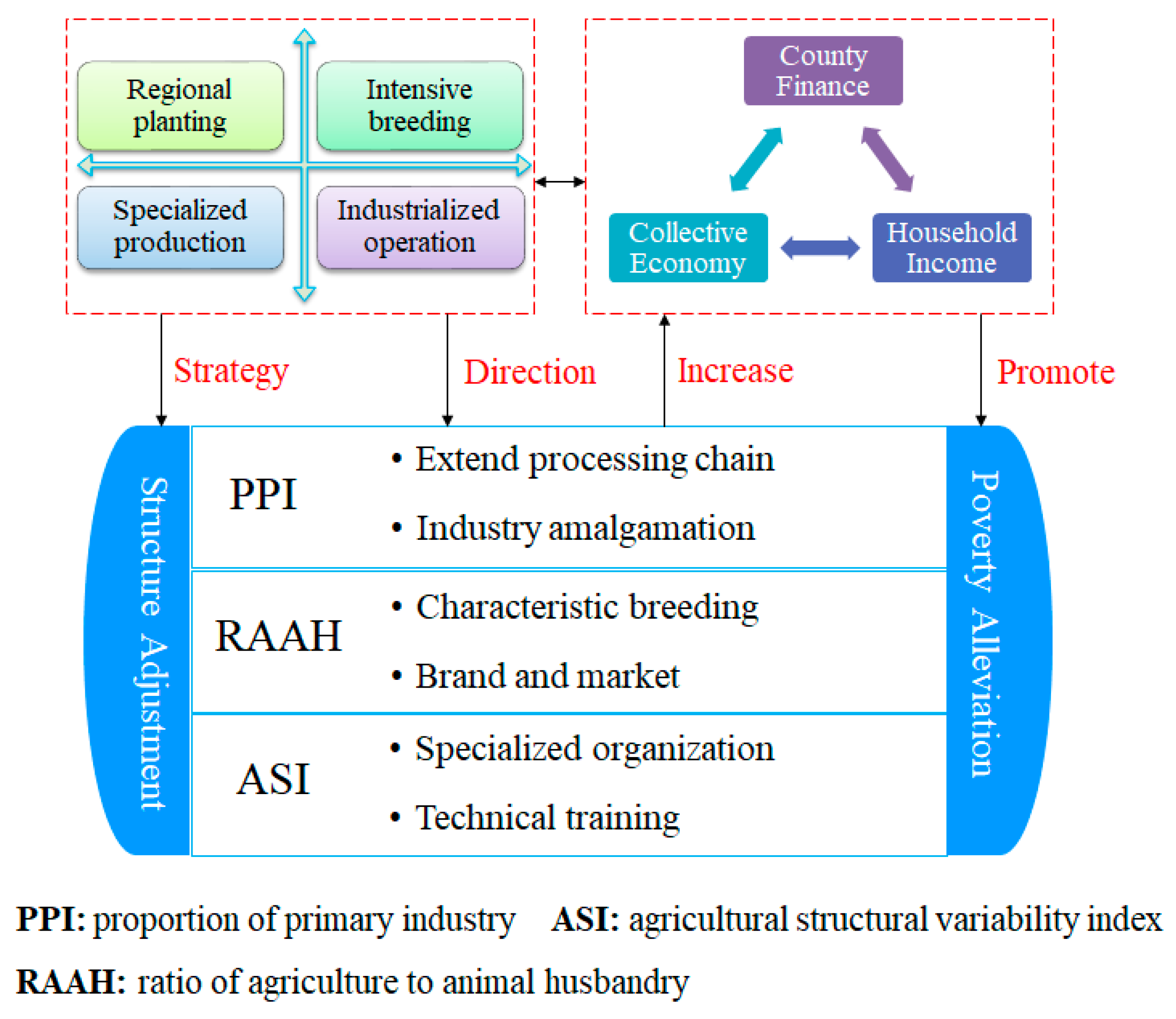
| County | 2008 | 2009 | 2010 | 2011 | 2012 | 2013 | 2014 | 2015 | 2016 | 2017 |
|---|---|---|---|---|---|---|---|---|---|---|
| Yuyang | 4185 | 5321 | 6605 | 8428 | 10,001 | 11,331 | 12,656 | 13,952 | 14,866 | 15,839 |
| Shenmu | 6028 | 7223 | 8672 | 10,798 | 12,537 | 13,225 | 13,622 | 14,740 | 15,569 | 17,537 |
| Fugu | 4703 | 5615 | 7786 | 9927 | 11,783 | 13,001 | 13,409 | 14,490 | 15,229 | 13,025 |
| Hengshan | 3380 | 4215 | 5264 | 6701 | 7860 | 8725 | 9364 | 10,246 | 11,008 | 14,195 |
| Jingbian | 4850 | 6031 | 7599 | 9689 | 11,413 | 12,680 | 13,086 | 14,395 | 15,247 | 16,236 |
| Dingbian | 3411 | 4524 | 6233 | 8010 | 9492 | 10,744 | 11,829 | 13,025 | 13,888 | 14,984 |
| Suide | 2941 | 3686 | 4564 | 5623 | 6630 | 7326 | 8227 | 9018 | 9727 | 10,550 |
| Mizhi | 3368 | 4209 | 5209 | 6407 | 7509 | 8290 | 8903 | 9718 | 10,482 | 11,371 |
| Jia | 2731 | 3435 | 4301 | 5458 | 6408 | 7254 | 8162 | 8941 | 9660 | 10,514 |
| Wubu | 2706 | 3515 | 4403 | 5582 | 6558 | 7352 | 8242 | 8997 | 9723 | 10,576 |
| Qingjian | 2767 | 3502 | 4386 | 5465 | 6500 | 7352 | 8234 | 9011 | 9695 | 10,542 |
| Zizhou | 2946 | 3693 | 4570 | 5621 | 6582 | 7394 | 8296 | 9049 | 9773 | 10,623 |
| Average | 3668 | 4581 | 5799 | 7309 | 8606 | 9556 | 10,336 | 11,299 | 12,072 | 12,999 |
| Dependent Variable | Independent Variable | Regression Equation | R2 | p Value |
|---|---|---|---|---|
| Poverty ratio | Proportion of primary industry (PPI) | Y = 0.4463PPI − 0.0059 | 0.83 | < 0.0001 |
| Ratio of agriculture to animal husbandry (RAAH) | Y = 0.0258RAAH + 0.0063 | 0.82 | < 0.0001 | |
| Agricultural specialization index (ASI) | Y = −0.6614ASI + 0.3349 | 0.46 | 0.0147 | |
| Combined | Y = 0.252PPI + 0.014RAAH − 0.009 | 0.91 | < 0.001 | |
| Agricultural Industry Development | County |
|---|---|
| Red date planting and processing | Jia, Wubu, Qingjian |
| Coarse cereals | Hengshan, Mizhi, Zizhou |
| Potato scale planting and processing | Dingbian, Jingbian |
| Apple | Suide, Jia, Wubu, Qingjian, Hengshan, Mizhi, Zizhou |
| livestock breeding and processing | Hengshan, Yuyang, Shenmu |
© 2020 by the authors. Licensee MDPI, Basel, Switzerland. This article is an open access article distributed under the terms and conditions of the Creative Commons Attribution (CC BY) license (http://creativecommons.org/licenses/by/4.0/).
Share and Cite
Wang, Y.; Chen, Y.; Liu, Z. Agricultural Structure Adjustment and Rural Poverty Alleviation in the Agro-Pastoral Transition Zone of Northern China: A Case Study of Yulin City. Sustainability 2020, 12, 4187. https://doi.org/10.3390/su12104187
Wang Y, Chen Y, Liu Z. Agricultural Structure Adjustment and Rural Poverty Alleviation in the Agro-Pastoral Transition Zone of Northern China: A Case Study of Yulin City. Sustainability. 2020; 12(10):4187. https://doi.org/10.3390/su12104187
Chicago/Turabian StyleWang, Yongsheng, Yan Chen, and Zhengjia Liu. 2020. "Agricultural Structure Adjustment and Rural Poverty Alleviation in the Agro-Pastoral Transition Zone of Northern China: A Case Study of Yulin City" Sustainability 12, no. 10: 4187. https://doi.org/10.3390/su12104187
APA StyleWang, Y., Chen, Y., & Liu, Z. (2020). Agricultural Structure Adjustment and Rural Poverty Alleviation in the Agro-Pastoral Transition Zone of Northern China: A Case Study of Yulin City. Sustainability, 12(10), 4187. https://doi.org/10.3390/su12104187






